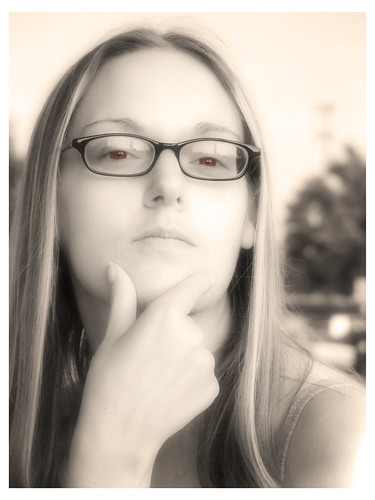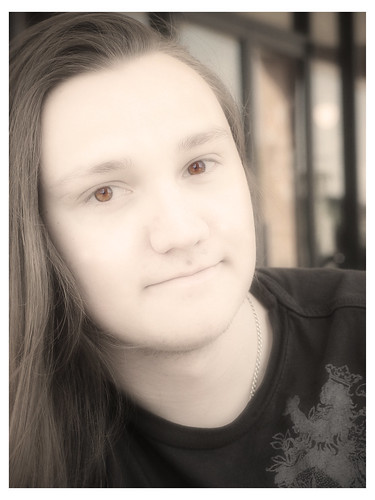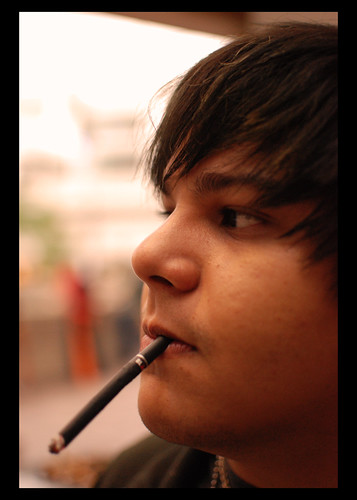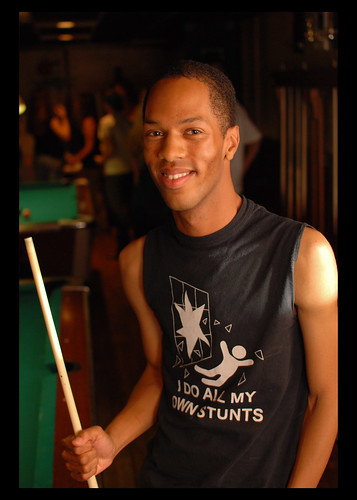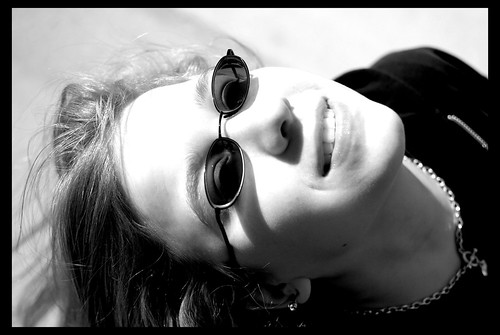The XZ-1, like most Olympus cameras of the level at least above their typical point-and-shoots, features on its mode dial a special little mode called "ART". I've tooled with it before, mainly the dramatic tone setting which brings out very stark, HDR-like image quality that can honestly either make or break any given scene. There are other settings in this particular mode as well - diorama, which gives a very misaligned tilt-shift look to things, high contrast black and white which literally permits each pixel of the image to be either black or white with no in-between (it works a charm in high-ISO situations, for sure), pinhole which looks as its name describes, all of which are certainly neat, not necessarily all particularly useful. One setting, however, I've developed something of an affinity for when doing my random candid snap shooting while sitting up at the coffee house bored to tears - portrait mode.
Unfortunately, when in an ART mode, most settings are handled automatically, allowing very little control over aperture and ISO and shutter speed, the trinity of essentials. Most fortunately, however, Olympus programmed the portrait mode to function much in the manner I would set it myself, maintaining the lowest possible aperture to best limited depth-of-field and handling the colors in just the warming way I would have treated them in post anyway. Then, to up the effect, the digital equivalent of a softening filter is applied to the resultant image, smoothing over all the harsh details better than I was ever able to achieve with a diffuse filter back when I was shooting weddings. The JPG results are truly beautiful, but seeing as I can't leave well enough alone, I have a tendency to apply my own little touch to the resultant images and much to my surprise find the files very receptive to the effects I apply.
Some time ago I stumbled upon a fun manner of producing very clean black and white portraits with digital. Whereas the use of a red filter while shooting in black and white did leave a person's face brighter than most of what surrounded it, the details in the skin were all typically still there. With digital, however, and especially with the way bayer matrices feature far more green photosites than red, the application of a red filter in post did something magical for faces. The blemishes, discolorations and little things like freckles vanished under the digital filter. Even better, when the adjustment layer saw its opacity reduced to allow some measure of color through, the face managed to retain the much cleaner appearance sought after with high level portraiture.
It only came to reason that I should try the tactic on a portrait shot in the appropriate ART mode. The results were glowing, quite literally. In-camera softening of the JPGs already smoothed over the fine details in the skin, the addition of the digital red filter completely eliminated them. Any extra clarity afforded by the RAW was not missed given the sharpness retained in the details that mattered. Having been a RAW guy for so long, it was so nice to find a mode on the camera that eliminated a good portion of the post work I would otherwise have to do the hard way.
No other point to this post, really, just a long thank you to Olympus for designing an extra set of modes that prove incredibly useful to people photographers.
Thursday, July 21, 2011
Tuesday, July 19, 2011
Two week later, JPGs still haunting
The uncertainty I'm experiencing in the selection of a new pro-body to use for my future photography is simply ridiculous. It should not be this difficult, the conundrum my mind has generated being several grades of retarded. A choice must be made, lest I fall in line with the legion of unfulfilled shooters in this digital world who won't invest in a system because it was planned to be released obsolete and replaced by the next high-tech fad only months later.
A friend came to me recently asking me for a patriotic photo to be used for the cover of his flag store's catalog. I was certain I had a fitting shot (which I was unfortunately unable to find before the deadline), so I proceeded to sift through the digital archive of photos I've taken since '04. It was a surreal experience, really, seeing the story of my life as told only incidentally by the photos strewn about the clusters of the disk. I had no idea that my innate inclination to photograph everything I see and do would ever amount to anything more than the select few I published online (and otherwise).
Once past the wall of indecipherable RAW formats that heavily populated all of 2011 and most of 2010, a gorgeous presentation of people photos dominated the theme of mid 2010 to about 2008. All were JPG, out-of-camera images shot with the D40x, and they were all gorgeous as-processed by that camera. They reminded me how much I miss that style of shooting, with no involved and numbing post-process necessary. That was all done beforehand, allowing the publishing process to quickly flow.
People don't much dominate my photography anymore, but I'm fairly confident that is because I traded in the ease of JPG shooting for a strict RAW process. And that transition was only due to a change in primary subject focus - I had been candidly snap shooting people for years, to the point where it came so naturally I wasn't impressed by the results anymore. The need arose for a new subject, so I traded in the Nikkor magic for the GF1 and perfected the shooting of decayed interiors as best as I could. Now I'm at another transitional period, with an interest equally in both people and static interiors. Two very different subjects, best shot with 2 very different approaches and most appreciated when approached with 2 very different post-process focuses in mind.
More and more the JPG output of my next pro-grade body is scaling the ladder of priority. Panasonic has never had very good JPG processing, only heavily detailed RAW files. For serious, static subjects, that is well and good, but I find my need for such heavy focus on the serious and static diminishing. I'm back to shooting people again, snapping at events and randomly while sitting at Starbucks. I do not want to be stranded in front of my computer for any amount of time to churn those files into usable images when the end result is ultimately only ever going to be a snapshot. Much as I love the G series that Panasonic has produced, impressed as I am by their bodies, their lenses and their image output, they will never be a strong replacement for candid people shooting until their JPG processing engine is heavily overhauled.
My choices are becoming increasingly difficult because I cannot adequately pursue my thematic affections without being invested in two systems. I am forced to choose between them. Panasonic has the best system for architectural and interior shooting, with in-camera correction of all distortion and aberrations in its RAW files so that, once in Photoshop, the hardest tasks are over and it all comes down to the artistic side of RAW processing. No matter what I do, I will always have a soft spot for Panasonic cameras and invest in them accordingly, they're simply that good.
For people shooting, however, my options open up and become much more difficult. In keeping with the MFT standard, Olympus has always been well known for having superb JPG output, with plenty of customization available for JPG processing and in-camera editing. With the recent release of their E-P3, a 45mm f/1.8 was also announced, a cheap and utterly fantastic lens for medium portrait shooting, making that camera seem a clear winner for dedicated people photography. On the flip, however, Fuji also has a camera equally up to the task of candid people shooting with the X100. Its APS-C sensor generates much cleaner higher ISO output, has just as much customization and flexibility with its JPGs and excels in just about ever area in candid people shooting, from flash sync to dynamic range retention. Of course, the issue there is its lack of interchangeable lenses (and the relatively wide 35mm equivalent lens isn't particularly geared to people shooting) and horrendous production schedule (the camera, ordered today, would take literal months to arrive, for sure). In both cases, severe compromise in some area is necessary, and it isn't yet clear to me what I'm willing to sacrifice.
Word in the rumor mill is that Fuji is in talks with MFT standard members Olympus and Panasonic about either potentially joining in the MFT standard or otherwise contributing to it. Panasonic hasn't yet released its scheduled GF1 spiritual successor, and I could only hope in a however unlikely miracle that the gift of Fuji to its potential MFT brethren is its JPG processing magic. If the GF1 successor churns out delicious JPGs then I would certainly love to a be a one-camera-system kind of guy. Today, however, with how things stand in the EVIL camera world, it appears I'll be waiting at least one more year before that kind of magic makes it way into the list of options. For now... choices...
A friend came to me recently asking me for a patriotic photo to be used for the cover of his flag store's catalog. I was certain I had a fitting shot (which I was unfortunately unable to find before the deadline), so I proceeded to sift through the digital archive of photos I've taken since '04. It was a surreal experience, really, seeing the story of my life as told only incidentally by the photos strewn about the clusters of the disk. I had no idea that my innate inclination to photograph everything I see and do would ever amount to anything more than the select few I published online (and otherwise).
Once past the wall of indecipherable RAW formats that heavily populated all of 2011 and most of 2010, a gorgeous presentation of people photos dominated the theme of mid 2010 to about 2008. All were JPG, out-of-camera images shot with the D40x, and they were all gorgeous as-processed by that camera. They reminded me how much I miss that style of shooting, with no involved and numbing post-process necessary. That was all done beforehand, allowing the publishing process to quickly flow.
People don't much dominate my photography anymore, but I'm fairly confident that is because I traded in the ease of JPG shooting for a strict RAW process. And that transition was only due to a change in primary subject focus - I had been candidly snap shooting people for years, to the point where it came so naturally I wasn't impressed by the results anymore. The need arose for a new subject, so I traded in the Nikkor magic for the GF1 and perfected the shooting of decayed interiors as best as I could. Now I'm at another transitional period, with an interest equally in both people and static interiors. Two very different subjects, best shot with 2 very different approaches and most appreciated when approached with 2 very different post-process focuses in mind.
More and more the JPG output of my next pro-grade body is scaling the ladder of priority. Panasonic has never had very good JPG processing, only heavily detailed RAW files. For serious, static subjects, that is well and good, but I find my need for such heavy focus on the serious and static diminishing. I'm back to shooting people again, snapping at events and randomly while sitting at Starbucks. I do not want to be stranded in front of my computer for any amount of time to churn those files into usable images when the end result is ultimately only ever going to be a snapshot. Much as I love the G series that Panasonic has produced, impressed as I am by their bodies, their lenses and their image output, they will never be a strong replacement for candid people shooting until their JPG processing engine is heavily overhauled.
My choices are becoming increasingly difficult because I cannot adequately pursue my thematic affections without being invested in two systems. I am forced to choose between them. Panasonic has the best system for architectural and interior shooting, with in-camera correction of all distortion and aberrations in its RAW files so that, once in Photoshop, the hardest tasks are over and it all comes down to the artistic side of RAW processing. No matter what I do, I will always have a soft spot for Panasonic cameras and invest in them accordingly, they're simply that good.
For people shooting, however, my options open up and become much more difficult. In keeping with the MFT standard, Olympus has always been well known for having superb JPG output, with plenty of customization available for JPG processing and in-camera editing. With the recent release of their E-P3, a 45mm f/1.8 was also announced, a cheap and utterly fantastic lens for medium portrait shooting, making that camera seem a clear winner for dedicated people photography. On the flip, however, Fuji also has a camera equally up to the task of candid people shooting with the X100. Its APS-C sensor generates much cleaner higher ISO output, has just as much customization and flexibility with its JPGs and excels in just about ever area in candid people shooting, from flash sync to dynamic range retention. Of course, the issue there is its lack of interchangeable lenses (and the relatively wide 35mm equivalent lens isn't particularly geared to people shooting) and horrendous production schedule (the camera, ordered today, would take literal months to arrive, for sure). In both cases, severe compromise in some area is necessary, and it isn't yet clear to me what I'm willing to sacrifice.
Word in the rumor mill is that Fuji is in talks with MFT standard members Olympus and Panasonic about either potentially joining in the MFT standard or otherwise contributing to it. Panasonic hasn't yet released its scheduled GF1 spiritual successor, and I could only hope in a however unlikely miracle that the gift of Fuji to its potential MFT brethren is its JPG processing magic. If the GF1 successor churns out delicious JPGs then I would certainly love to a be a one-camera-system kind of guy. Today, however, with how things stand in the EVIL camera world, it appears I'll be waiting at least one more year before that kind of magic makes it way into the list of options. For now... choices...
Subscribe to:
Posts (Atom)

